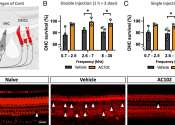Using light instead of electricity in cochlear implants
A team of researchers affiliated with multiple institutions in Germany has developed a cochlear implant that converts sound waves to light signals instead of electrical signals. In their paper published in the journal Science ...








